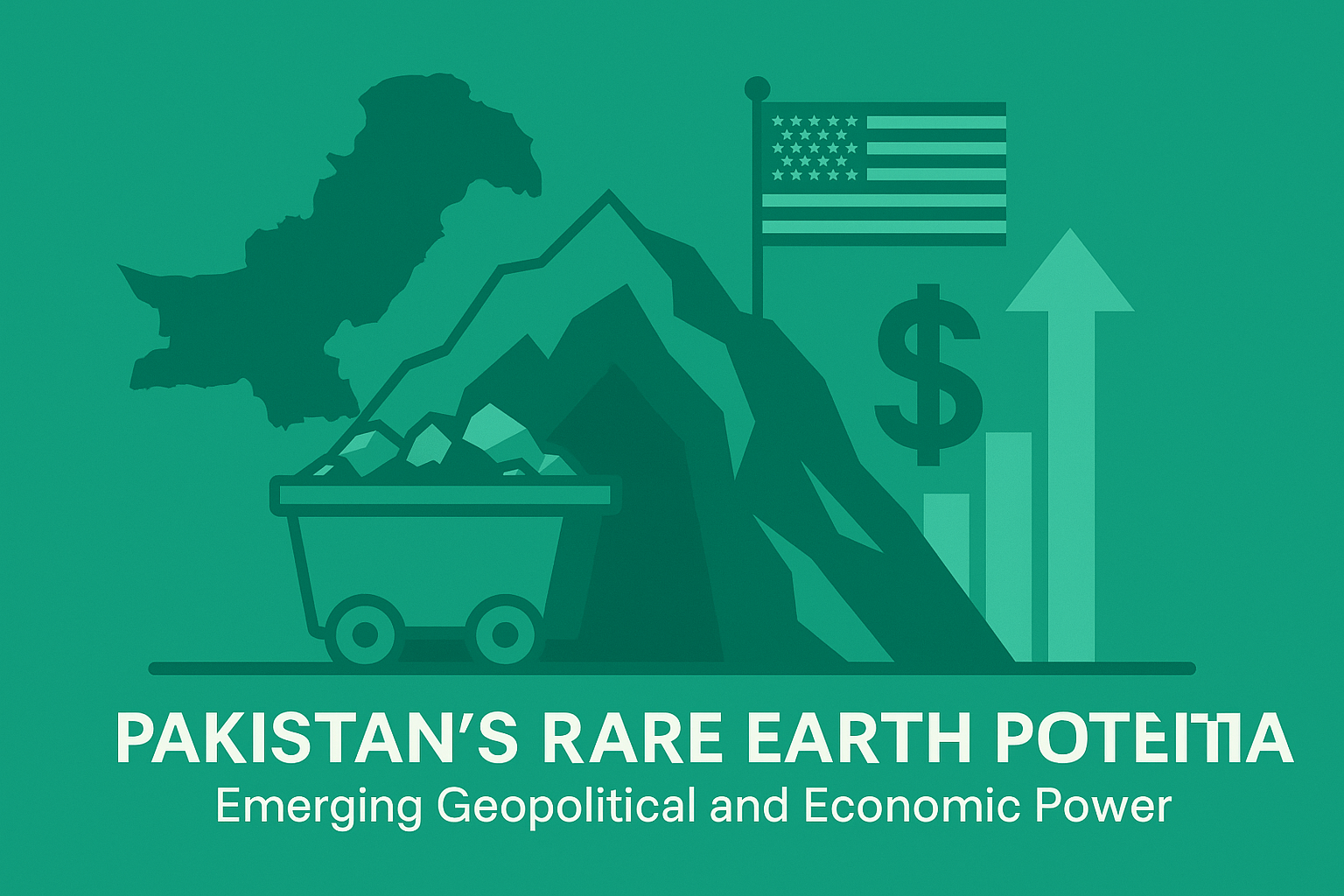— Emerging as a “Third Supply Source” in the U.S.–China Strategic Rivalry —
(Economic Analysis Report, October 2025)
- 1. Overview
- 2. Resource Potential and Geological Background
- 3. Policy Dynamics and U.S. Engagement
- 4. Economic Implications and Industrial Challenges
- 5. Geopolitical Context: Toward a New “Strategic Resource State”
- 6. Outlook and Scenario Analysis
- 7. Implications for Japan and International Financial Institutions
- 8. Conclusion
1. Overview
Pakistan has recently positioned its untapped mineral resources as a core component of its national strategy, drawing significant global attention—particularly in the field of rare earth elements (REEs).
In late September 2025, the government signed a US$500 million mineral cooperation framework with the United States and conducted its first-ever shipment of rare earth–bearing ore.
This milestone marks more than a commercial transaction; it signals the country’s ambition to leverage “mining diplomacy” as an instrument of economic recovery and geopolitical repositioning amid intensifying U.S.–China competition.
2. Resource Potential and Geological Background
Pakistan’s mineral wealth is concentrated across three major regions:
- Balochistan,
- Khyber Pakhtunkhwa, and
- Gilgit–Baltistan.
These areas are geologically complex and rich in polymetallic deposits—primarily copper, gold, and zinc—where rare earth elements such as neodymium (Nd), praseodymium (Pr), and yttrium (Y) often occur as by-products.
According to independent estimates (Rare Earth Exchanges, 2025), Pakistan’s rare earth potential could reach up to US$6 trillion in theoretical value. However, this figure reflects inferred potential, not confirmed commercial reserves.
Systematic exploration, drilling, and verified resource mapping remain at a nascent stage.
3. Policy Dynamics and U.S. Engagement
(1) The First Shipment and Its Strategic Symbolism
In September 2025, Pakistan dispatched its first shipment of rare earth materials to the United States.
While the precise grade, purity, and quantity remain undisclosed, this act symbolically positioned Pakistan as a potential “alternative supply source” for critical minerals in Washington’s strategic calculus.
The initiative aligns with the Trump administration’s Critical Minerals Alliance, aimed at reducing U.S. dependence on Chinese imports and reinforcing domestic and allied supply chains.
(2) Balancing Between Beijing and Washington
Historically, Pakistan has been a cornerstone of the China–Pakistan Economic Corridor (CPEC) under the Belt and Road Initiative, relying heavily on Chinese financing for infrastructure and mining projects.
The recent U.S. engagement represents an embryonic shift toward a multi-alignment diplomacy, signaling Islamabad’s intent to diversify its strategic partnerships while maintaining ties with Beijing.
4. Economic Implications and Industrial Challenges
(1) Potential Economic Catalyst
Rare earth exports could help Pakistan mitigate its chronic current account deficits and foreign exchange shortages.
Beyond fiscal relief, mining development and related logistics infrastructure could stimulate local employment and regional growth—particularly in underdeveloped provinces.
(2) Structural Constraints
However, the sector faces multiple systemic challenges:
- Limited geological data and verified reserves
- Underdeveloped refining and transport infrastructure
- Security risks in insurgency-prone regions (notably Balochistan)
- Opaque governance and overlapping authority between federal, provincial, and military bodies
These factors collectively undermine investor confidence and long-term project predictability.
(3) Technological and Capital Gaps
Rare earth processing demands advanced separation and purification technologies—domains still dominated by China.
To achieve global competitiveness, Pakistan will require joint ventures and technology transfers from partners such as the U.S., Japan, or Australia.
5. Geopolitical Context: Toward a New “Strategic Resource State”
Rare earth elements underpin key industries—semiconductors, defense, renewable energy, and advanced electronics.
In this context, Pakistan’s emergence as a potential REE supplier carries geopolitical significance far beyond its borders:
- For the United States: A supplementary source to dilute Chinese dominance.
- For China: A regional test case for retaining influence under competing U.S. offers.
- For India: A strategic variable in South Asian resource security.
In essence, Pakistan’s rare earth strategy represents “resource diplomacy” as strategic diversification—a novel blend of economic ambition and geopolitical calculation.
6. Outlook and Scenario Analysis
| Scenario | Description | Economic Outcome | Geopolitical Consequence |
|---|---|---|---|
| A. U.S.-Aligned Growth Path | Deepening cooperation with U.S. and allied investors; access to capital and technology | Export growth, industrial upgrading | Reinforces U.S.-centric resource bloc |
| B. Balanced Multi-Alignment | Parallel engagement with both U.S. and China under pragmatic diplomacy | Diversified inflows, moderate growth | Maintains strategic flexibility |
| C. Domestic Disruption & Stagnation | Political turmoil or security setbacks derail projects | Capital flight, unrealized potential | Loss of credibility, isolation |
At present, Scenario B (Balanced Multi-Alignment) appears most plausible.
However, persistent political volatility could easily shift the trajectory toward Scenario C.
7. Implications for Japan and International Financial Institutions
- Reassessing Risk–Return Profiles
While diversification of rare earth supply benefits global stability, Pakistan’s political and operational risks require cautious valuation.
Financial institutions should emphasize structured finance and risk mitigation instruments (e.g., NEXI insurance). - Scope for Technical Partnerships
Japan’s expertise in rare earth processing and recycling offers a natural synergy.
Collaborative exploration or refining initiatives—possibly under JBIC/JOGMEC frameworks—could enhance resource security while promoting sustainable development. - Green Finance and Strategic Resources
Given REEs’ critical role in EVs, renewable energy, and high-performance magnets, integration with climate-aligned resource finance mechanisms would align with Japan’s broader decarbonization agenda.
8. Conclusion
Pakistan’s rare earth sector sits at the intersection of economic opportunity and geopolitical realignment.
Its trajectory will depend heavily on:
- Governance transparency and regulatory coherence,
- Security stabilization in mining regions, and
- Effective partnerships with foreign investors.
If successful, Pakistan could emerge as South Asia’s third strategic mineral hub, reshaping the global supply map.
If mismanaged, however, its “US$6 trillion potential” risks becoming yet another case of resource illusion—undermined by politics, opacity, and insecurity.
Strategic Insight
Pakistan’s rare earth diplomacy represents a test case for how emerging economies can convert natural resources into geopolitical leverage.
Its evolution over the coming decade will serve as a key indicator for the reconfiguration of Asian supply chains and the future architecture of global resource finance.


